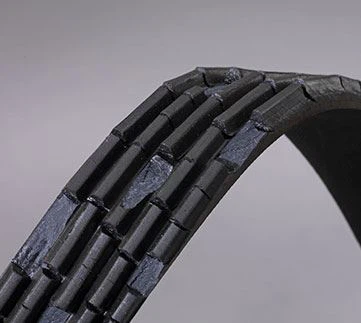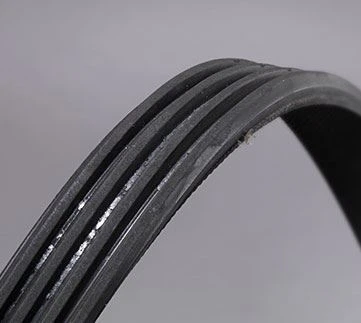Features
● High temperature resistance comparable to HNBR
● Cold resistance better than ASCM, HNBR and CR
● Good wear and pilling resistance
● Alternator serpentine belt linear belt speeds up to 60 m/s
● Fits pulleys better, running stably with lower noise
Specification
SPECIFICATION | ||||||
Section | Width (mm) | Thickness (mm) | Rib Pitch (mm) | Min. Pulley Dia. (mm) | Manufacturing Range | |
Min. (mm) | Max. (mm) | |||||
3PK | 10 | 4.5 | 3.56 | 45 | 300 | 5000 |
4PK | 13.6 | 4.5 | 3.56 | 45 | 300 | 5000 |
5PK | 17 | 4.5 | 3.56 | 45 | 300 | 5000 |
6PK | 20.7 | 4.5 | 3.56 | 45 | 300 | 5000 |
7PK | 24.3 | 4.5 | 3.56 | 45 | 300 | 5000 |
8PK | 27.8 | 4.5 | 3.56 | 45 | 300 | 5000 |
9PK | 31.4 | 4.5 | 3.56 | 45 | 300 | 5000 |
10PK | 35 | 4.5 | 3.56 | 45 | 300 | 5000 |
11PK | 37.4 | 4.5 | 3.56 | 45 | 300 | 5000 |
12PK | 40.8 | 4.5 | 3.56 | 45 | 300 | 5000 |
Applications
Alternator drive belts widely used in Automotive industry.
Alternator serpentine belt wear analysis

① CHUNK-OUT
Appearance: Pieces or chunks of rubber material have come off the belt. When chunk-out has occurred, a belt can fail at any moment.
Cause: Chunk-out can happen when several cracks in one area move parallel to the cord line. Heat, age and stress are the primary contributors.
Solution: Replace with a Pioneer alternator serpentine belt, which is designed for greater flexibility and heat tolerance in today's smaller engine compartments.

② PILLING
Appearance: Belt material wears off from the ribs and builds up in the belt grooves.
Cause: There are a number of causes, including misalignment, new belt on worn pulleys, lack of tension or a combination of these factors. Pilling will occur most frequently in diesel engines, but is not isolated to them.
Solution: When pilling leads to belt noise or excess belt vibration, the belt should be replaced. Make sure the new belt runs on perfect pulleys. Check the tensioner and ensure proper belt tension on a properly aligned drive.







